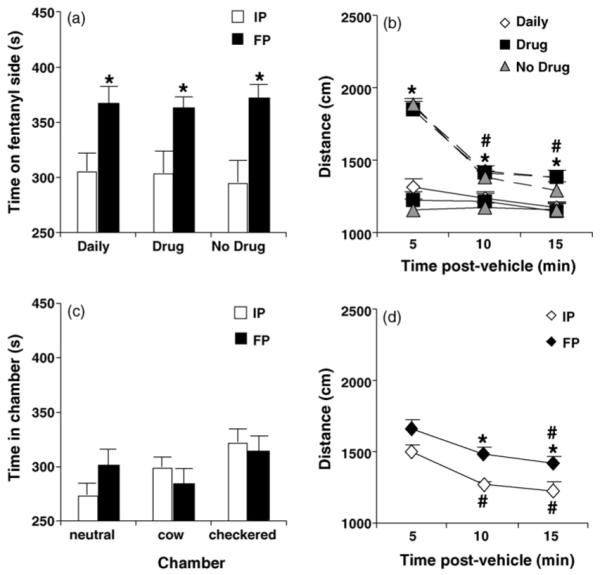Fig. 6.

Effect of drug expectation on conditioned place preference and locomotion. (a) Fentanyl administration to demonstrator mice during training served as a cue for predicting simply an injection (“Daily”), predicting drug on the drug-paired side (“Drug”) or for predicting vehicle on the vehicle-paired side (“No Drug”) in observer mice (see Table 2). On Test Day, 10 min following fentanyl administration to demonstrators, observers of all three groups were tested for Final Preference. IP = Initial Preference over 15 min. FP = Final Preference over 15 min. There was no effect of demonstrator cues on the expression of conditioned place preference (p > 0.05). All three groups of observer mice showed significant preference for fentanyl (* = different from IP; p < 0.05). (b). There was no effect of demonstrator cues on locomotor activity during FP (p > 0.05). Mice exhibited greater activity during FP (dashed lines) compared to IP (solid lines; *p < 0.05; collapsed across observer groups) and greater activity during the first 5 min of FP compared to 10 min or 15 min (#p < 0.05; collapsed across observer groups). (c) No change in time spent in the three chambers from IP to FP in separate, naive mice given vehicle injections in both environments during training (p > 0.05). Neutral = neutral chamber (gray). Cow = cow-print chamber. Checkered = checkered chamber. (d) There was a significant increase in locomotor activity during FP at the 10-min and 15-min time bins (*p < 0.05). # = Significantly different from the 5-min bin (p < 0.05). Data are presented as the mean ± S.E.M.
